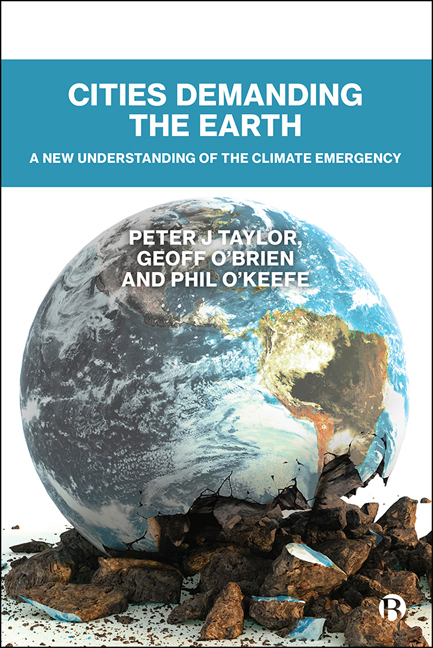Book contents
- Frontmatter
- Dedication
- Contents
- List of Tables and Figures
- About the Authors
- Preface
- 1 Declarations: Root and Branch Unthinking
- 2 Alternate: Jane Jacobs’ legacy
- 3 Inside Out: Fourteen Antitheses Authenticating Cities
- 4 Reset: Anthropogenic Climate Change is Urban, not Modern
- 5 Action: Can We Stop Terminal Consumption?
- References
- Appendix: Primer on Climate Change Policy
- Index
Appendix: Primer on Climate Change Policy
Published online by Cambridge University Press: 19 March 2021
- Frontmatter
- Dedication
- Contents
- List of Tables and Figures
- About the Authors
- Preface
- 1 Declarations: Root and Branch Unthinking
- 2 Alternate: Jane Jacobs’ legacy
- 3 Inside Out: Fourteen Antitheses Authenticating Cities
- 4 Reset: Anthropogenic Climate Change is Urban, not Modern
- 5 Action: Can We Stop Terminal Consumption?
- References
- Appendix: Primer on Climate Change Policy
- Index
Summary
Many believe that climate change is the greatest threat we face. But there are others who do not. Although the international community has put in place a system for tackling climate change, it is not making sufficient progress to avoid a global temperature rise that could lead to dangerous climate events. In addition, although there is increasing evidence of adverse events being driven by climate change, some nations such as the USA do not support actions, and the energy producers are clearly using their immense political influence to limit efforts being made to reduce conventional energy use. This Primer discusses climate change and posits that cities are best placed to lead on reducing greenhouse gas emissions as well as the adaptations needed to deal with changes driven by climate change.
Climate change is a natural phenomenon that depends on relationships between the Earth, Moon, Sun and other planets in our solar system and the composition of the Earth's atmosphere. The amount of what are termed ‘greenhouse gases’, such as carbon dioxide (CO2), determine how much energy from the sun is trapped in the atmosphere. The more greenhouses gases present, the more heat is trapped, and the warmer the atmosphere becomes. This is called the ‘greenhouse effect’, a natural phenomenon that fluctuates cyclically. Over time the Earth has experienced both ice ages and warm periods, with the last ice age ending some 12,000 years ago.
With the advent of the Industrial Revolution, increasing use of fossil fuels massively increased the amount of greenhouse gases, particularly CO2, emitted into the atmosphere. This has grown from a concentration of some 280 parts per million (ppm) prior to the Industrial Revolution to some 400ppm today. And it is still growing. Since the Industrial Revolution the global average temperature has risen by 1 degree Celsius. Climate scientists believe that a rise of more than 1.5 degrees Celsius will lead to dangerous climate change.
What has been the response? The international community has recognised the dangers of climate change. In 1994 the United Nations Framework Convention on Climate Change (UNFCCC) came into force. Its role is to find the means of reducing greenhouse gas emissions. It initially set a target to reduce emission rates to 1990 levels by 2000. This proved to be completely unrealistic, and in 1997 UNFCCC established the Kyoto Protocol.
- Type
- Chapter
- Information
- Cities Demanding the EarthA New Understanding of the Climate Emergency, pp. 137 - 144Publisher: Bristol University PressPrint publication year: 2020



